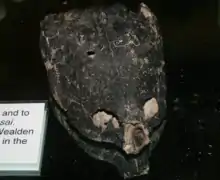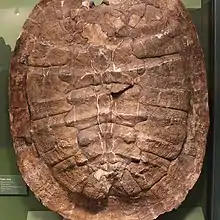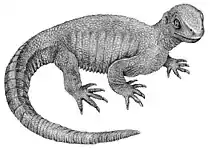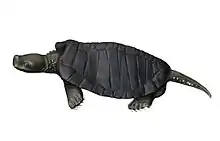Helochelydridae
The Helochelydridae are an extinct family of stem-turtles known from fossils found in North America and Europe that have been dated from the Late Jurassic to the Late Cretaceous.[1][2] Although referred to as Solemydidae in recent literature on extinct turtles, Helochelydridae has priority over Solemydidae.[3] The skull, shell and osteoderms of helochelydrids are covered in small, cylindrical protuberances, which are a distinctive characteristic of the group.[4] They are thought to be terrestrial, based on the presence of limb osteoderms and bone histology.[5] Their skull morphology is dissimilar to that of extant tortoises, suggesting an omnivorous habit similar to that of box turtles.[6] Their phylogenetic placement has been unclear, a 2021 analysis placed them within the family Pleurosternidae.[7]
| Helochelydridae Temporal range: | |
|---|---|
 | |
| Helochelydra nopcsai skull | |
 | |
| Shell of Naomichelys | |
| Scientific classification | |
| Kingdom: | Animalia |
| Phylum: | Chordata |
| Class: | Reptilia |
| Clade: | Pantestudines |
| Clade: | Testudinata |
| Clade: | Perichelydia |
| Family: | †Helochelydridae Nopsca, 1928 |
| Synonyms[1] | |
|
Solemydidae Lapparent and Murelaga 1997 | |
Genera
- Aragochersis[8] Escucha Formation, Spain, Early Cretaceous (Albian)
- Helochelydra Wessex Formation, England, Early Cretaceous (Barremian)
- “Helochelydra” anglica (Lydekker, 1889) Purbeck Group, United Kingdom, (Berriasian)
- “Helochelydra” bakewelli Mantell, 1833 Tunbridge Wells Sandstone, England, (Valanginian)
- Helochelys Grünsandstein Formation, Germany, Late Cretaceous (Cenomanian) , Cambridge Greensand, England, Albian-Cenomanian, France, Spain, Cenomanian
- Naomichelys Cretaceous (Aptian-Campanian) North America
- Plastremys Upper Greensand Formation, Cambridge Greensand, England, Albian-Cenomanian, Spain, Albian France, Cenomanian
- Solemys France, Spain, Late Cretaceous (Campanian-Maastrichtian)
Indeterminate remains most similar to “Helochelydra” anglica and “Helochelydra” bakewelli have been reported from the Berriasian aged Angeac-Charente bonebed of France.[9]
References
- "†Helochelydridae Nopsca 1928". Paleobiology Database. Fossilworks. Retrieved 17 December 2021.
- Joyce WG; Rabi M; Clark JM; Xu X. (2016). "A toothed turtle from the Late Jurassic of China and the global biogeographic history of turtles". BMC Evolutionary Biology. 16 (1): 236. doi:10.1186/s12862-016-0762-5. PMC 5084352. PMID 27793089.
- Joyce, Walter G. (2017). "A review of the fossil record of basal Mesozoic turtles" (PDF). Bulletin of the Peabody Museum of Natural History. 58 (1): 65–113. doi:10.3374/014.058.0105. S2CID 54982901. Retrieved July 9, 2017.
- Gentry, Andrew D.; Ebersole, Jun A. (2021-08-10). "The first occurrence of the stem turtle Naomichelys from the Late Cretaceous of eastern North America". Historical Biology: 1–8. doi:10.1080/08912963.2021.1962855. ISSN 0891-2963.
- Scheyer, T. M.; Pérez-García, A.; Murelaga, X. (March 2015). "Shell bone histology of solemydid turtles (stem Testudines): palaeoecological implications". Organisms Diversity & Evolution. 15 (1): 199–212. doi:10.1007/s13127-014-0188-0. ISSN 1439-6092. S2CID 18628827.
- WALTER, J.G., CHAPMAN S.D., MOODY R.T.J., and WALKER, C.A. 2011. The skull of the solemydid turtle Helochelydra nopcsai from the Early Cretaceous of the Isle of Wight (UK) and a review of Solemydidae IN BARRETT, P.M. and MILNER, A.R. (eds.) Studies on Fossil Tetrapods. Speicial Papers in Palaeontology, 86, 75-97.
- Rollot, Yann; Evers, Serjoscha W.; Joyce, Walter G. (December 2021). "A redescription of the Late Jurassic (Tithonian) turtle Uluops uluops and a new phylogenetic hypothesis of Paracryptodira". Swiss Journal of Palaeontology. 140 (1): 23. doi:10.1186/s13358-021-00234-y. ISSN 1664-2376.
- A. Pérez-García; E. Espílez; L. Mampel; L. Alcalá (2019). "A new basal turtle represented by the two most complete skeletons of Helochelydridae in Europe". Cretaceous Research. 107: Article 104291. doi:10.1016/j.cretres.2019.104291.
- Ronan Allain, Romain Vullo, Lee Rozada, Jérémy Anquetin, Renaud Bourgeais, et al.. Vertebrate paleobiodiversity of the Early Cretaceous (Berriasian) Angeac-Charente Lagerstätte (southwestern France): implications for continental faunal turnover at the J/K boundary. Geodiversitas, Museum National d’Histoire Naturelle Paris, In press. ffhal-03264773f

